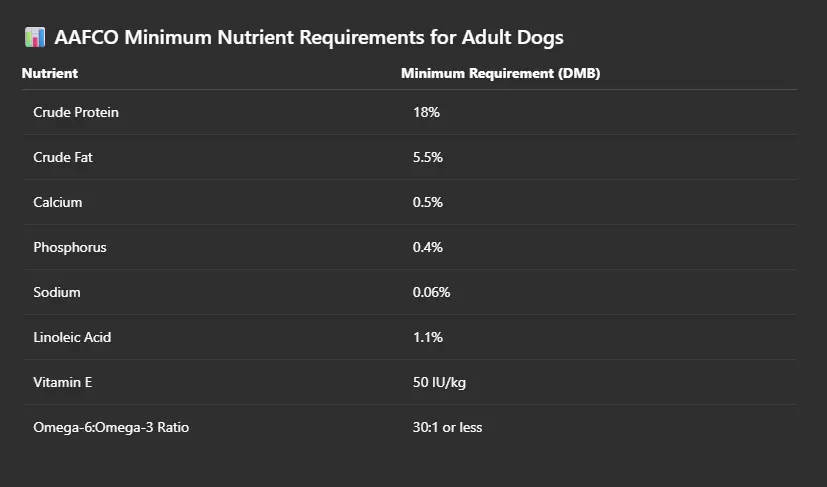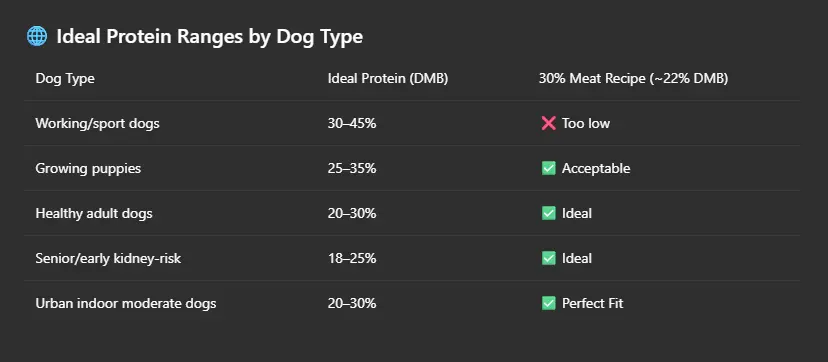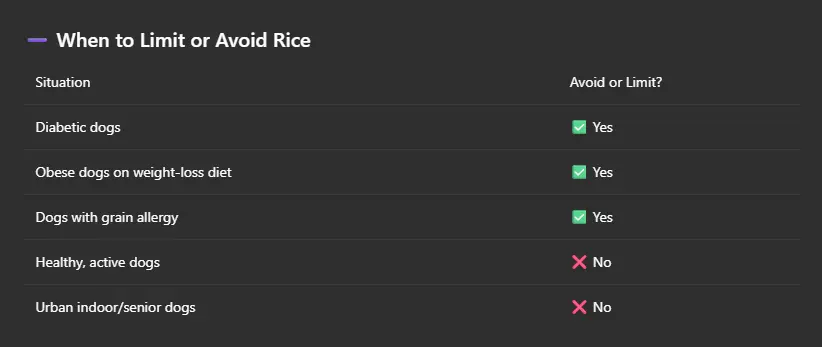
🍽️ Estimated Protein Content of 30% Chicken (As Fed and DMB)
Assuming skinless raw chicken has ~22% protein as fed:
- 30g chicken (in a 100g total recipe) → 30g x 22% = 6.6g crude protein
- If food is ~70% moisture, Dry Matter = 30g
- Protein on DMB = (6.6g / 30g) x 100 = 22% DMB
This fits neatly into a kidney-friendly range for adult, city-living dogs.


🥣 So What Should You Do?
If your goal is to create a general-purpose, safe-for-most adult dogs formula, especially for urban or indoor dogs, then:
- ✅ Consider adding rice or veggies to lower protein
- ✅ Reduce phosphorus and kidney load
- ✅ Provide clean, digestible energy
- ✅ Balance satiety and GI health
- ✅ Cut formulation costs without compromising health
This approach still meets or exceeds AAFCO guidelines for adult maintenance.
🍚 Will 25% Cooked White Rice Spike Blood Sugar?
Short answer: Not significantly, when used in a complete and balanced meal.
- White rice has a high GI (70–90), but glycemic load is moderated by fiber, fat, and protein.
- At 25% inclusion, the rice still contributes useful energy without overwhelming the glucose regulation system in most healthy dogs.
- For urban, adult dogs, this is unlikely to cause problems if paired with lean meat and fiber-rich veggies.
⚖️ Risk/Benefit Analysis at 25% Rice:
Potential Benefits:
- Clean, digestible energy
- Improved satiety and GI regularity
- Cost-effective
- Protein dilution for kidney support
Potential Risks (when unchecked):
- May not be suitable for diabetic dogs
- Can increase glycemic load in overweight dogs
- Slight reduction in overall protein and micronutrient density
Overall: ✅ Still acceptable for general maintenance diets, especially for city and early senior dogs.

🔬 Scientific & Industry References
- Studies show cooked rice is >95% digestible by dogs
- Dogs evolved more AMY2B genes for starch digestion
- Whole grains help gut health via resistant starch and fiber
- FDA's DCM review pointed at legumes, not grains, as a risk
Key Journals & Findings:
- Dogs tolerate grains better than legumes in many studies
- No evidence that grains alone cause allergies or obesity

🔑 Origin & Rise of Grain-Free Dog Diets
- Emerged after 2007 pet food recalls
- Pet food brands marketed "grain-free" as superior and safer
- Tied to human clean eating and paleo trends
- Fueled by fear-based marketing, not medical necessity
- Studies show no benefits of grain-free for most dogs
🔁 Conclusion: Including Grains Is Perfectly Okay
Grains like white rice (15–30%) can be a smart part of a balanced dog diet:
- ✅ Help reduce protein/phosphorus load
- ✅ Easy to digest
- ✅ Safe for urban, adult, and early-senior dogs
- ✅ Meet AAFCO nutrition standards
Dogs are not wolves. They have evolved to digest starch, and unless your dog has a specific diagnosis, there's no need to avoid grains. In fact, a 30:45:25 meat-veggie-rice split is often ideal for city dogs.
At Momo&Co, we use grains thoughtfully, not fearfully. Because good food isn’t about trends. It’s about balance.